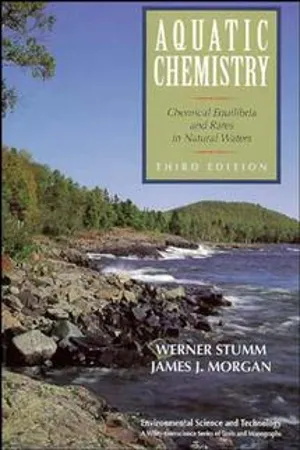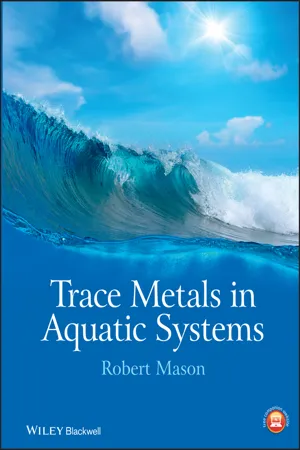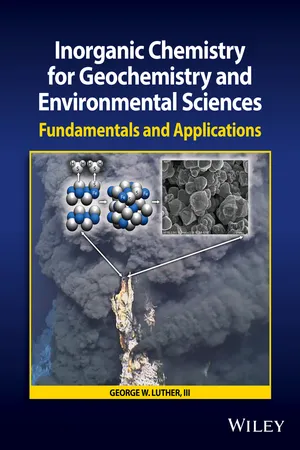Chemistry
Transition Metal Ions in Aqueous Solution
Transition metal ions in aqueous solution refer to the behavior of transition metal ions when they are dissolved in water. These ions can form complex ions with water molecules, leading to the formation of coordination complexes. The presence of transition metal ions in aqueous solution can affect the color, reactivity, and other properties of the solution.
Written by Perlego with AI-assistance
Related key terms
Related key terms
1 of 4
Related key terms
1 of 3
5 Key excerpts on "Transition Metal Ions in Aqueous Solution"
- eBook - ePub
Aquatic Chemistry
Chemical Equilibria and Rates in Natural Waters
- Werner Stumm, James J. Morgan(Authors)
- 2012(Publication Date)
- Wiley(Publisher)
CHAPTER 6
METAL IONS IN AQUEOUS SOLUTION: ASPECTS OF COORDINATION CHEMISTRY
6.1 INTRODUCTION
All chemical reactions have one common denominator: the atoms, molecules, or ions involved tend to improve the stability of their electron configuration, that is, of the electrons in their outer shell. In a broad classification of chemical reactions, we distinguish between two general groups of reactions by which atoms achieve such stabilization. (1) Redox processes, in which the oxidation states of the participating atoms change, and (2) reactions in which the coordinative relationships change. What do we mean by a change in coordinative relations? The coordinative relations change if the coordinative partner changes or if the coordination number† of the participating atoms is changed. This may be illustrated by the following examples.1. If an acid is introduced into water,the coordinative partner of the hydrogen ion (which has a coordination number of 1) is changed from ClO− to H2 O.2. The precipitation that frequently occurs in the reaction of a metal ion with a base,can be interpreted in terms of a reaction in which the coordinative relations are changed, in the sense that a three-dimensional lattice is formed in which each metal ion is surrounded by and coordinatively “saturated” by the appropriate number of bases.3. Metal ions can also react with bases without formation of precipitates in reactions such asIn this simple classification of reactions, no distinction needs to be made between acid–base, precipitation, and complex formation reactions; they are all coordinative reactions, hence phenomenologically and conceptually similar.Concentrations of Heavy Metals in Natural Waters
Table 6.1 gives some data on heavy metal concentrations in lakes; rivers, and oceans. The concentrations of dissolved metal ions are remarkably low (10−7 –10−11 - eBook - ePub
- Robert P. Mason(Author)
- 2013(Publication Date)
- Wiley-Blackwell(Publisher)
+ essentially dissolves completely in water. In contrast, most transition metal ions do not predominantly exist in solution as the free metal ion and are mostly in the form of complexes. A variety of terms are used to describe the type of associations that occur ranging from those that are relatively ionic in nature to those that have substantial covalent characteristics. Mercury, for example, forms linear complexes with some ligands, such as chloride, where the bond is essentially covalent.For many of the trace metals, including transition metals, their empty d and f orbitals within the electronic shell have a dramatic impact on the extent of complex formation and their characteristics such as their paramagnetism and propensity to form colored solutions [7]. For metals and metalloids that have filled d and f orbitals, understanding their behavior in terms of complex formation is somewhat simpler. Therefore, a brief discussion of the inorganic chemistry theory related to complex formation by transition metals is warranted.3.2.1 Ligand Field Theory
The discussion here will be focused on the Ligand Field Theory to describe transition metal interactions in solution [7]. Here a simplified description will be given, focusing on examples of 3d orbital interactions (for the first row transition metals). The following designations will be used: oxidation states will be denoted by Roman numerals (e.g., +I, +II, −IV) while the charge on a particular ion or species will be represented by numerals as a superscript (e.g., Cu2+ , Cl− ). This is done to avoid confusion, for example, between the discussion of the +II oxidation state for Cu (Cu(II) or CuII ) and that of the free metal ion, Cu2+ . Given the order at which orbitals are filled, the atoms of the metals of the first row of the transition series have the electron configuration of Ar4s 2 3d x , where x differs for the different elements of the series. There are two exceptions and these are due to the enhanced stability of the electronic configuration for d 5 , which occurs when there is one electron in each d orbital, or d 10 , where the orbitals are full. Given the enhanced stability of these configurations, the atoms of Cr have an electronic structure of Ar4s 1 3d 5 , and those of Cu, Ar4s 1 3d 10 , as opposed to structures with two 4s electrons [7]. This also explains, for example, the fact that Cu is found as a +1 cation to a greater degree in the environment than other transition metals, and the same is true for one of its counterparts in Group 11, Ag, which does not exist in the +II oxidation state to any significant degree. Gold, the final member of this group, is mostly found in the +III oxidation state, or the +I state, and does not exist in solution as a free ion. Besides these elements, it is the outer electrons from the 4s - eBook - ePub
Environmental Process Analysis
Principles and Modeling
- Henry V. Mott(Author)
- 2013(Publication Date)
- Wiley(Publisher)
Table 10.2 , we would likely find direct correlations between hydrated ion size and enthalpy of hydration. Each class of elements likely would have its own correlation between hydrated radius and enthalpy of hydration, dependent upon ionic charge and position in the periodic table. The degree to which an ion becomes hydrated affects the interactions with other species in aqueous solutions and certainly the influence of the ion upon the overall behavior of the aqueous solution. Then, also the degrees to which ions hydrate affect their behaviors in myriad natural and engineered environmental systems. One notable correlation of hydrated radius with ionic behavior is the lyotropic series—the smaller the hydrated radius of the cation or anion, for a given ionic charge, the more strongly attracted the ion would be to a cation or anion exchange site of a an ion exchange resin (Weber, 1972) or, certainly, to a site of negative or positive charge on a natural surface (Bohn et al., 1979). Were we to continue along this thread, we would investigate the properties of water in the vicinity of the charged sites, judge whether the ions would shed their waters of hydration, examine the diffuse layer within the context of the triple layer model, and examine what the soil chemists call “intrinsic” equilibrium coefficients. This examination would perhaps require another book or two—a great deal has been published about this general topic. Such examination is beyond the scope of this text. Let us become comfortable with interactions between metals and ligands in homogeneous aqueous solutions and then address some of those interactions with the solids they form.Our goal herein is not the development of quantitative understandings of the molecular-level properties and specific interactions between metals and ligands. Again, we will leave those efforts to the chemists. Our goal is to become aware that metal ions and (certainly to a lesser degree) anions (many of which are complexing ligands) are associated at the molecular level with water in aqueous solutions. Manifestations of these behaviors are included in the system of chemical equilibria developed by the chemists. We would choose herein to become proficient in the use of that system for modeling environmental processes and systems.11.3 CUMULATIVE FORMATION CONSTANTS
11.3.1 Deprotonation of Metal/Water Complexes
While hydration of metals is certainly related to the hydrolysis of metals, the two phenomena are distinct from each other. Hydration addresses the association of water with ions while hydrolysis addresses the behavior of certain of those water molecules, once associated with ions, most typically metal cations. In addressing hydrolysis of cations, we work with a principle the chemist call the coordination number. It is effectively the number of short-range bonds that a metal cation may have with water molecules in an aqueous solution. Coordination numbers are typically two, three, four, and six, as the coordinated metal–water entities must be symmetric about the nucleus of the ion, where the positive charge arises once outer shell electrons have been shed. Excellent treatises on the intricate details of the hydrolysis of cations and of the associated thermodynamics were published by Baes and Mesmer (1976, 1981). The first is a book while the second is a journal article.In general, a metal becomes associated with water molecules via short range bonds. From our work with acids and bases, we know that water is the conjugate acid of hydroxide. These bound water molecules then can donate protons to species present in the surrounding aqueous solution. In theory, since water is the conjugate base of hydronium, these bound water molecules could accept protons. This behavior likely would occur only under conditions of large proton abundance, atypical of natural and certainly most engineered aqueous systems. We will consider only the donation of protons by these bound water molecules. Then, the hydrated metal becomes in effect a multiprotic acid. Since coordination numbers typically range from two to six, from two to six short-range bonds can be formed between the metal and water molecules. In general, the number of protons that can be donated from these bound water molecules determines whether the metal–ligand complex would act similarly to a diprotic, triprotic, tetratprotic, pentaprotic, or hexaprotic acid. - eBook - ePub
- Michael Matson, Alvin W. Orbaek(Authors)
- 2013(Publication Date)
- For Dummies(Publisher)
There is also kinetic stability, and this deals with the reactivity of the compounds, and for the most part this refers to the speed at which a ligand can bind to a metal atom, and the speed for a ligand to be released from the metal atom. This is called a ligand exchange. In short, it describes the situation where one ligand is replaced by another.Water is a good ligand and has been used to determine water exchange rates for many metals, and metals with a variety of oxidation states. The values can serve as a general guide to gauge what you might expect to happen for a certain metal ion as per the oxidation state. It’s particularly useful if you want to compare the relative reaction rates of two different metals, or to determine the relative reaction rates of the same metal but with different oxidation states.For the most part, but not always, as the metal oxidation state increases,the rate of exchange decreases. Water exchange is also referred to as water replacement in some textbooks.Transition metals and d-block elements form stable complexes that are more stable than the other elements. Metal ions require a combination of three factors to form a stable complex, all of which are common in transition metals and d-block elements:A high ionic charge (+2, +3, and higher) so that donated electrons from the ligand are attracted by the positive nucleus of the cation.A small ionic radius so that the ligands can get closer for maximum binding affinity and as a result, stronger bond strength.Partially filled external, or frontier, orbitals are available for bonding with the ligands. The presence of the free orbitals allows for the formation of a covalent complex. This is because the electrons that are donated by the ligands are placed in the vacant orbitals, and this is why the d-block atoms form covalent bonds with ligands. And this is why the transition metals form the majority of organometallic complexes that are known. This is important later when talking about d-orbital splitting and crystal field theory.Grouping geometriesThe shape of a coordination complex is a result of the bonding arrangement of the ligands around the metal center of the complex ion. The way that the ligands are attached to the metal atom causes the entire compound to adopt a certain shape (see Figure 9-1 - eBook - ePub
Inorganic Chemistry for Geochemistry and Environmental Sciences
Fundamentals and Applications
- George W. Luther(Author)
- 2016(Publication Date)
- Wiley(Publisher)
(an inner sphere electron transfer process).10.2 Factors Governing Metal Speciation in the Environment and in Organisms
Many factors affect the reactivity of a metal ion in the environment. Section 1.8.2 indicated that the oxidation state of a metal [e.g., Fe(II) versus Fe(III)] depends on the redox condition of the environment. For example, once dissolved and are consumed, microbes decompose organic matter with other oxidants such as and FeOOH, resulting in reduction to and . Metal ions can exist as inorganic complexes with the following common inorganic ligands: chloride, carbonate, sulfate, phosphate, and sulfide. However, there are a variety of organic ligands that are naturally produced and that outcompete the inorganic ligands for bonding with metal ions. Ligands also affect the redox and spin state of a metal couple such as Fe(III)/Fe(II) (Section 8.7.3 for Co; Table 10.1 for Fe), and nature uses ligand–metal bonding to affect reactivity and catalysis. The left of Figure 10.1 shows potentials for several reduction couples that are important in life processes (sometimes termed a redox spectrum). An oxidized partner of a redox couple at the top such as can be reduced by the reduced partner of any couple below it as . Thermodynamically, the couple is one of the most efficient, but it also shows the energy needed for water splitting (the reverse reaction that requires photochemistry; Section 10.7 ). The FeS proteins (see Section 12.6.4 ) have different oxidation states and ligand attachments that tune their redox potential over 1 volt; reduction of to is possible for some redox centers (ferredoxins). Selected aspects of the redox chemistry for the metal redox centers in Figure 10.1 are described below and in Chapter 12
Index pages curate the most relevant extracts from our library of academic textbooks. They’ve been created using an in-house natural language model (NLM), each adding context and meaning to key research topics.
Explore more topic indexes
Explore more topic indexes
1 of 6
Explore more topic indexes
1 of 4




